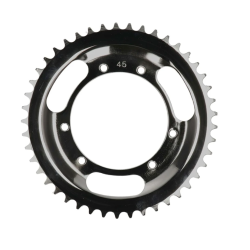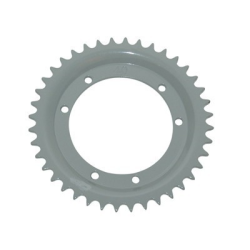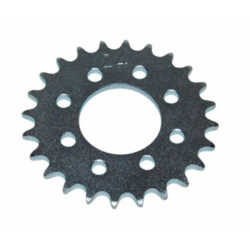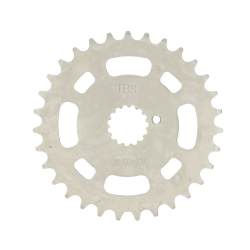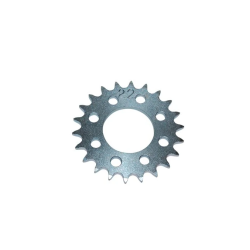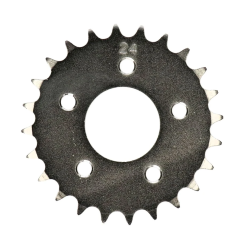The best scooter shop in 2025
Rear Sprocket Moped
Rear Sprocket Puch Maxi – 40 Teeth – 415 Chain
Rear Sprocket Tomos 24 Teeth – 415 Chain – DMP
Rear Sprocket Tomos 22 Teeth – 415 Chain – DMP
Rear Sprocket Puch Maxi – 42 Teeth – 415 Chain
Rear Sprocket Puch Maxi – 38 Teeth – 415 Chain
Rear Sprocket Moped: The Key to Speed and Performance
The rear sprocket of a moped plays a crucial role in the drivetrain and is responsible for transferring power from the chain to the rear wheel. The way the rear sprocket interacts with the front sprocket determines the gear ratio, which directly influences the speed and acceleration of your moped. In this text, we will delve deeper into how the gear ratio of a moped works.
How does the gear ratio of a moped work?
The gear ratio is an important factor that determines how your moped performs. It describes the ratio between the number of teeth on the front sprocket and the number of teeth on the rear sprocket. This ratio affects both the acceleration and top speed of your moped. Here are some key points about how the gear ratio works:
-
Calculation of the Gear Ratio:
- The gear ratio is calculated by dividing the number of teeth on the rear sprocket by the number of teeth on the front sprocket.
- For example: if you have a rear sprocket with 50 teeth and a front sprocket with 15 teeth, then the gear ratio is 50:15, which simplifies to 3.33:1. This means that for every 3.33 rotations of the front sprocket, the rear sprocket makes one full rotation.
-
Influence on Acceleration and Top Speed:
- Higher Gear Ratio: A higher gear ratio (for example 4:1) means you have more power at the start and the moped accelerates faster. This is ideal for city traffic and hilly roads, where you often need to accelerate and decelerate.
- Lower Gear Ratio: A lower gear ratio (for example 2:1) can result in a higher top speed, but less acceleration. This is beneficial for long rides on the highway, where you want to maintain a constant speed without frequently accelerating.
-
Tuning to Riding Style and Conditions:
- Riders can tune the gear ratio to their personal riding style and the conditions in which they ride most. If you often ride in the city, a higher gear ratio may be more suitable, while a lower ratio is better for long rides on the highway.
- Replacing the rear sprocket or the front sprocket is a relatively simple adjustment that you can make yourself or have done by a professional.
-
Impact on Chain Wear:
- An incorrect gear ratio can also affect the wear of the chain and sprockets. Too much load on the chain can lead to faster wear, while a too low load can reduce performance. It is essential to tune the ratio well to ensure a long lifespan of the components.

 Nederlands
Nederlands